A. Focus on Climate Change
Having the word “planet” in our name doesn’t mean we’re going to try to solve all the planet’s problems. The United Nations has listed 17 Sustainable Development Goals. We have chosen to act on one, Goal 13: the fight against global warming.
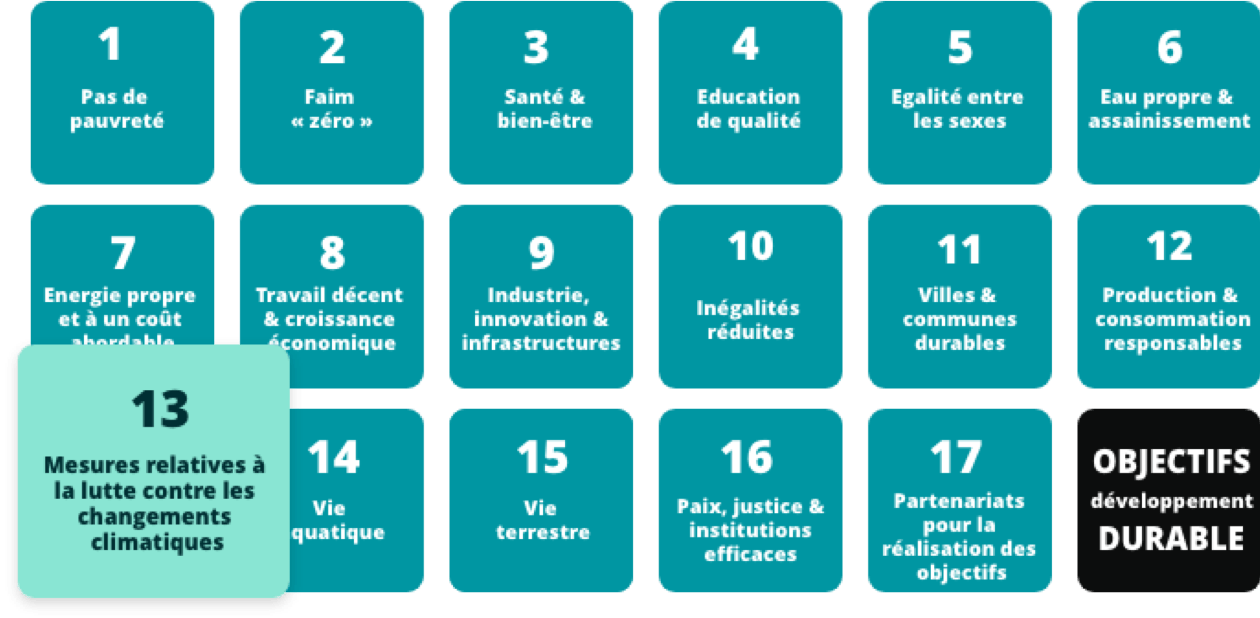
Overpopulation, social and economic inequality, climate migration, health risks - even populism - are all directly or indirectly related to global warming, but they are completely outside Team for the Planet’s scope for action. Not because they’re not real, or because they are any less important; nor that we are not concerned by them. We have chosen to act on issues we can control directly, where we don’t have to depend on politicians or large-scale change in individual behavior. We don’t want to bite off more than we can chew!
We can’t address all environmental issues.
The environment is particularly important to us, and there are countless environmental issues.
For the first time in 2009, then in an updated form in 2015, researchers proposed a list of nine planetary boundaries. This approach was adopted by the United Nations, Europe, and most recently France. These boundaries set limits that mankind must respect to live in a sustainable and safe ecosystem.
Apart from climate change, the nine boundaries include loss of biodiversity, disruption of nitrogen and phosphorus cycles, freshwater use and preservation of the ozone layer.
Once again, it would be impossible to address all these problems. A focused approach is more efficient. That’s why we have decided to concentrate on climate change. For example, we won’t try to find solutions to desalinate seawater or to protect endangered animal species.
Reducing GHG and targeting carbon neutrality
Within the scope of climate change, we have narrowed our action down to a single goal: funding solutions that mitigate greenhouse-gas emissions to achieve carbon neutrality. Quickly and globally!
As a result, we exclude:
- Innovations that have no direct and significant impact on GHG emissions.
Take plastic.
We won’t try to solve the problem of plastic in the oceans. It causes terrible levels of pollution that seriously impact biodiversity. However, according to current knowledge, plastic in the oceans has a negligible impact on the climate. The capacity to absorb dissolved CO2 by phytoplankton is decreasing but the impact is low.
On the other hand, plastic production and other industries are within our scope of action because they have significant impact on GHG emissions.
Funding a new bank that only invests in green projects, for example, does not have enough direct impact on our main goal of reducing greenhouse gases.
- Innovations with indirect and unmeasurable effects
Take education and raising awareness about climate change.
Don’t get us wrong. We are particularly passionate about this at Team for the Planet, as we hope this article demonstrates. We believe that education is vital. We strive - and will continue to strive - to explain the urgency of the situation.
On the other hand, we will not fund educational projects, such as a mobile app that measures the GHG impact of supermarket purchases. Of course, such projects are essential, but measuring their direct impact is too difficult. How can you predict whether a person will change their behavior and to what degree?
We have decided to focus on direct and measurable effects on GHG.
- Innovations that cannot be reproduced or upscaled worldwide
Many individuals are organizing personal projects at a local level. Despite being both admirable and exciting, we won’t count on local projects that are often tailor-made. We are looking for scalable innovations that can be standardized and deployed quickly and globally to save time and optimize impact.
- The nuclear issue
The nuclear issue is a highly contentious debate. Team for the Planet does not wish to take a stand on this issue, either ideologically or for investment purposes.
We simply support two claims:
- The general public often has a preconceived idea about nuclear energy,
thinking it is a major source of greenhouse-gas emissions. This is not
true. In fact, it is one of the lowest GHG emitting energies, often
referred to as “low-carbon” energy. - On the other hand, nuclear energy should not be considered as readily
renewable. Uranium is now a finite resource, just like fossil fuels. It
is also a resource that underpins major geopolitical and security
challenges which we do not wish to be involved in.
Nor will we express our opinion about using nuclear energy as a short-term buffer. As a result, we will not finance any innovations in the nuclear sector.
Neither sorcerer’s apprentices nor climate engineers
The more we postpone action against global warming, the more tempting geoengineering becomes. What is geoengineering?
Geoengineering, also known as climate engineering, makes “front-line and large-scale” corrections to manipulate the climate. Rather than trying to reduce the causes of global warming due to GHG emissions, it tries to control the consequences.
A regularly cited example is the injection of massive amounts of sulfur or its derivatives into the atmosphere as sulfate aerosols. It has been shown that radiative forcing of such elements can be negative and cool the planet. Sending aerosols into the atmosphere would increase the albedo, slowing global warming. But aerosols only stay in the atmosphere for a limited time. Injections would therefore be required at regular intervals.
This type of action is extremely risky:
- Firstly, the side effects are difficult to anticipate, particularly for health: aerosols have been shown to be harmful.
- Secondly, if for some reason - technical or geopolitical for example -
we were no longer able to send aerosols into the atmosphere to
compensate for GHG, the greenhouse effect on the climate would be very
sudden. Consequent global warming would be immediate and extremely
violent.
That’s why we’ve decided to focus on the causes: GHG emissions and how to reduce them, and not geoengineering.
B. Our Strategy: Four Mitigating Actions
Team for the Planet’s goal is clear: drastically reduce GHG emissions to reach carbon neutrality as quickly as possible.
We have identified four complementary and indispensable actions:
1. Zero emissions: develop energy sources and materials that do not emit GHG.
2. Energy efficiency: improve the efficiency of current systems to reduce their energy consumption and associated emissions.
3. Mindfulness: reduce our needs to limit GHG mechanically in the entire production chain.
4. Capture: directly and indirectly capture GHG emissions to limit their concentration in the atmosphere.
1. Zero emissions or decarbonization
The first action is decarbonization also referred to as decarbonation.
The aim is to develop solutions - radical innovations - that contribute to carbon neutrality. This includes shifting from using fossil fuels that emit GHG to decarbonized, renewable energy.
Carbon neutrality is a long-term vision. Significant research and development are required, but investment is vital now if it is to be achieved.
This action is essential, but it’s not enough. It is impossible to change all of society at once. A transition phase is essential, not only technologically but also socially, politically and economically. Team for the Planet can contribute to the transition, helping various players to move quickly with innovative and attractive solutions.
2. Energy efficiency
Energy efficiency is a short- to medium-term action. We must limit energy waste in existing processes and systems until we reach carbon neutrality. This limits total energy consumption - and therefore GHG emissions - during the transition phase. Many improvements are already in place for the production, processing and consumption of carbon energy. However, there is enormous potential for innovative systems, equipment and machinery to optimize our energy efficiency.
Improving energy efficiency alone would be insufficient to achieve large-scale energy transition. As one of four complementary actions, however, it can have a rapid and crucial impact across all sectors of activity, being widely acceptable and easy to implement.
3. Mindful consumption
Reducing our consumption is an important action for the short term and will also have significant impact in the long term. Reducing all our needs - such as travel, goods, buildings and food - has a mechanical and almost immediate effect on our GHG emissions. The global drop observed during COVID-19 lockdowns is a case in point.
Such global changes in our lifestyles will have significant and long-lasting impact. Choices must be natural, positive, economical and accessible to encourage the majority of people to be mindful and reduce their consumption. For example, it’s easy to choose to get around by bike if it’s quicker than going by car.
4. Carbon capture
The final action is to develop solutions to capture GHG.
At first glance, capture may seem to address the consequences of global warming rather than the causes. That’s not necessarily the case. GHG emissions are cyclical: capturing and storing them is a natural form of regulation.
Take forests: trees absorb CO2 to store it as biomass, emitting oxygen as they do. In other words, preventing the deterioration and promoting the development of carbon sinks is a GHG capture solution that addresses the causes.
Carbon capture is an essential element of an ambitious mitigation strategy that aims to reduce global warming to 1.5°C, as demonstrated in the latest IPCC scenarios.
Finally, capture can contribute to neutralizing human-generated emissions that are already in the atmosphere. Solutions are now being developed to capture existing CO2 in the atmosphere. These solutions are vital for rapid transition, but they should not be considered to be sufficient or desirable in the fight against global warming.
C. Our Scope: Five Priority Sectors
Team for the Planet plans to take effective action to reduce GHG emissions. To do so, it is essential to identify the most important sources of GHG emissions generated by human activity.
IPCC reports provide the breakdown between the different sectors of our economy for 2010.
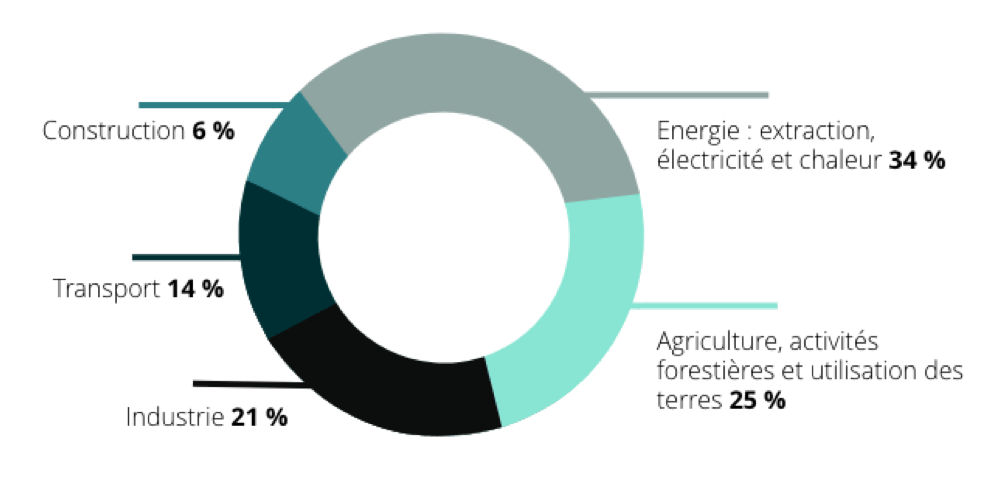
Source: IPCC 5th Assessment Report, 2010 data.
Note: this is a global analysis but the situation varies greatly from country to country. Factors include:
- Geographic location (cold or hot country, mountainous, coastlines)
- Demographics (number of households to feed and heat)
- Available natural resources (rivers, oil, biomass)
- GDP per capita (people in “rich” countries consume more)
- Energy mix (breakdown of energy sources: fossil fuels, nuclear power, renewable energy)
- National policy, particularly for energy transition (support for coal plants or insulating buildings)
Energy – The Heart of the Reactor
The conclusion about GHG emissions is clear and final: the energy sector is a major problem.
According to the IPCC, in 2010, the energy-production sector accounted for approximately 34% of global GHG emissions. This includes emissions generated by extraction and processing.
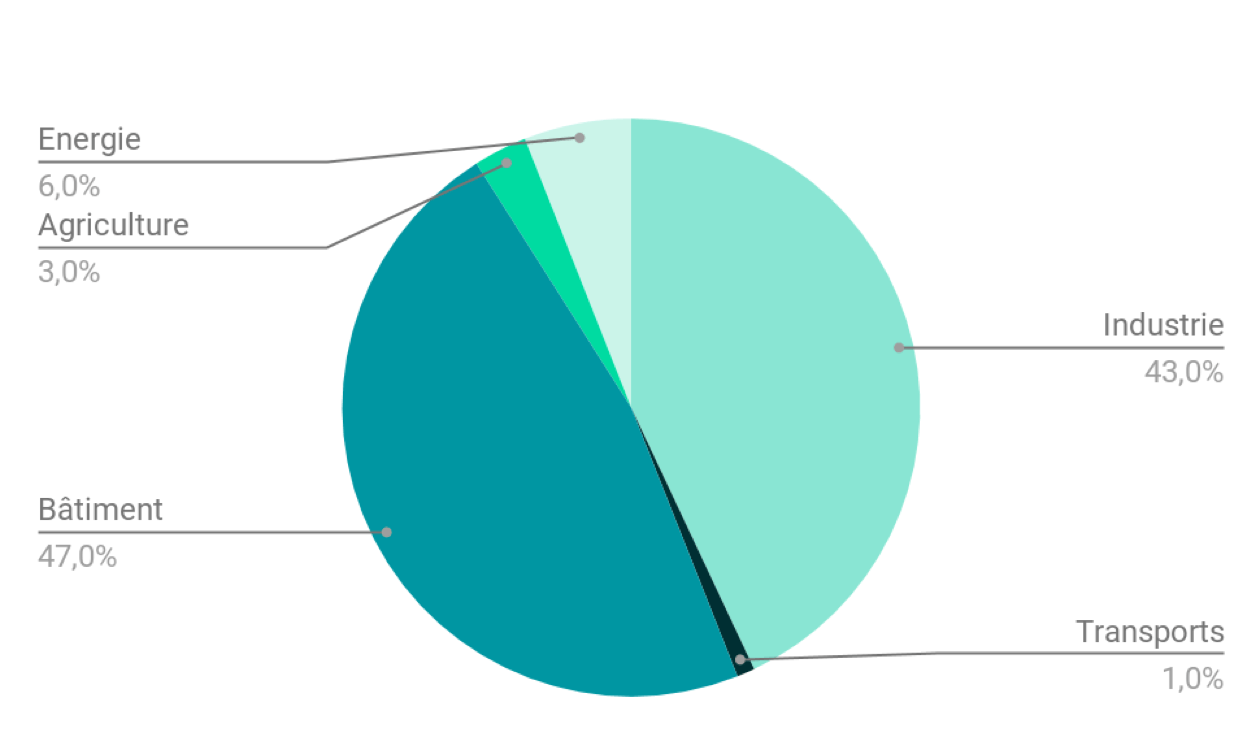
Breakdown of indirect GHG generated by the energy sector
Whether for electricity or generating heating, the sector’s GHG emissions are directly related to the massive use of fossil fuels - over 80%.
Beyond debate on stock levels of fossil resources (oil, gas and coal), it is essential to shift the global energy mix to other low-carbon sources.
Industry – The Energy Glutton
Industry is the second largest GHG-emitting sector:
- It uses the most energy resources, and is also one of the major GHG-emitting sectors in the world: 44% of energy.
- Industrial processes also emit 21% of the world’s GHG. For example, in cement production, reducing limestone (CaCO3) to lime (CaO) generates CO2. In other words, it is chemically impossible to avoid CO2 emissions when producing cement.
In total, cement production is responsible for 32% of global GHG emissions.
The three industries that emit the most GHG are steel, heavy chemistry and cement production.
Transport – The Oil King
Transport accounts for almost 15% of global GHG emissions - mainly CO2. Note, however, that emissions from producing means of transport, such as cars and planes, are accounted for in the industry sector. The 15% of GHG emissions attributed to transport are due to fuel consumption.
Road transport is by far the worst culprit, with 10.5% of global emissions. Road transport includes light and heavy vehicles, everything from motorbikes and cars to trucks. Global air transport emissions are around 2%.
It’s true that your individual carbon footprint is much higher if you travel by plane rather than by car, but the volume of road trips worldwide has a much greater impact than air travel.
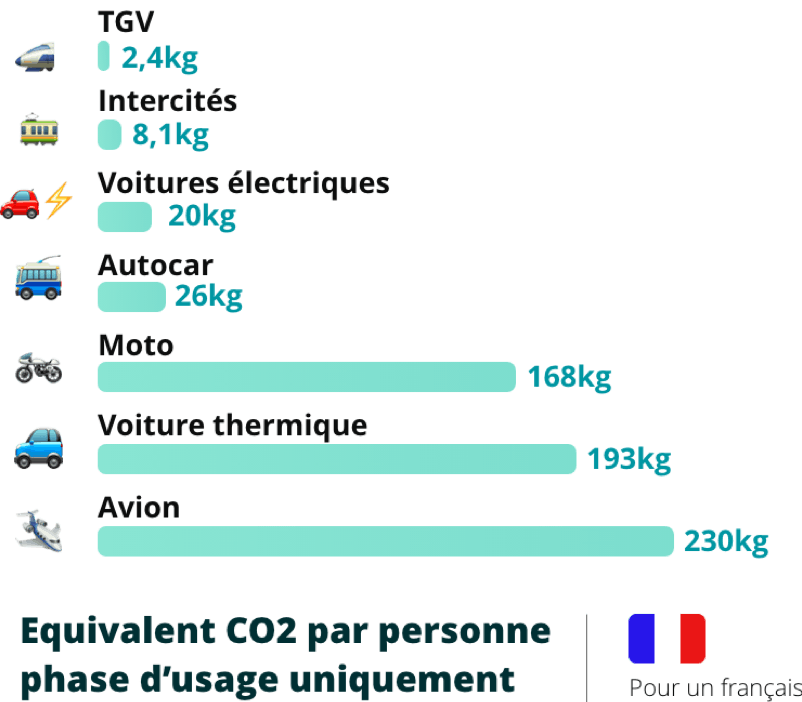
Impact for 1000 km, in France
Farming – The All Round Champion
Agriculture and land use account for 24% of GHG according to the IPCC.
The sector accounts for the bulk of global emission of non-CO2 gases: two-thirds of methane (CH4) and nitrous oxide (N2O) are generated by agriculture, due to cattle breeding and use of fertilizer respectively.
Livestock breeding emits more than the transport sector. Breeding causes emissions through animal feed and enteric fermentation generated by livestock which ruminate and release methane.
Emissions due to crops are mainly generated by mineral and organic nitrogen fertilization (mineral fertilizers, sludge, compost and animal waste), basic soil amendments (limestone, dolomite) and rice farming. Rice itself does not produce GHG. The decomposition of organic matter in flooded rice fields produces methane which escapes into the atmosphere through air bubbles and rice plants.
Farming contributes to CO2 emissions as it is part of the “agriculture, forestry and other land use” category. It therefore takes into account carbon flows due to the development of carbon sinks caused by forest management, agricultural soils, afforestation, artificialization, prairie laboring, etc.
Finally, deforestation, mainly due to agricultural expansion, land-to-pasture conversion, destructive logging and forest fires, accounts for 11% of global GHG emissions.
Buildings – The Essential Building Blocks
Buildings account for just over 6% of global GHG emissions. This includes residential and commercial buildings.
GHG emissions related to the building life cycle are included in this sector. Emissions from construction are not included. Making building materials, including cement, is accounted for in the industry sector figures. Given the nature of emissions, the figures for the buildings sector vary greatly around the world because needs differ according to climate.
Most of the GHG emissions from buildings are generated by heating and air conditioning. That’s why energy performance plays a key role: a well-insulated building requires less heating or cooling.
Heating and air conditioning use fossil fuels and hydrofluorocarbons (HFCs). These are gases primarily used as refrigerants in air conditioners and refrigerators, or as propulsion agents in aerosols. They are made with carbon, fluorine and hydrogen atoms. Powerful GHGs, they heat up to 14,800 times more than CO2.
There is enormous potential to reduce current GHG emissions, but environmental advocates insist that action is too slow. In order to meet the objectives of the Paris Agreement, the Global Alliance for Buildings and Construction, hosted by the UNEP, aims to improve energy consumption by 30% in the buildings and construction sector.
The development of new techniques, tools, products and technologies (heat pumps, improved windows, better insulation, energy-efficient appliances and smarter design) had stabilized emissions. However, they are increasing due to growing numbers of air-conditioning systems and intense climate events such as heat waves.
Digital: The New Sector on the Rise
In addition to the five major sectors responsible for human-generated GHG emissions, we have included a bonus sector: digital. Why “bonus”?
Unfortunately, the sector has not yet been specifically analyzed in global studies. There are no data available about the digital sector, even by country. The only attempt to quantify the sector’s impact was made by the Shift Project. However, the results should be taken with a pinch of salt because they have not been subjected to international scientific review.
What is certain, however, is that the growing digital sector generates GHG. According to the first figures, the carbon footprint may increase by 9% per year. Causes include:
- Energy for manufacturing equipment such as servers, networks and terminals that are currently accounted for in the figures for the industry and energy sectors.
- The proliferation of digital devices such as smartphones and connected objects which are frequently renewed, are currently accounted for in the industry sector.
- A boom in data traffic and video usage (Netflix, YouTube and more recently during Covid-19 lockdowns, Zoom and Skype) uses significant bandwidth which is currently accounted for in the industry sector.
According to a French Senate report in 2019, the digital sector produced 3.7% of the world’s greenhouse gases, and 2% of France’s total emissions. That’s a total of 15 million tons of CO2. This figure could rise to 6.7% of the national total by 2040, well above air travel at 4.7%. If it were ranked as a country, the digital sector would be the fifth largest CO2 emitter globally.
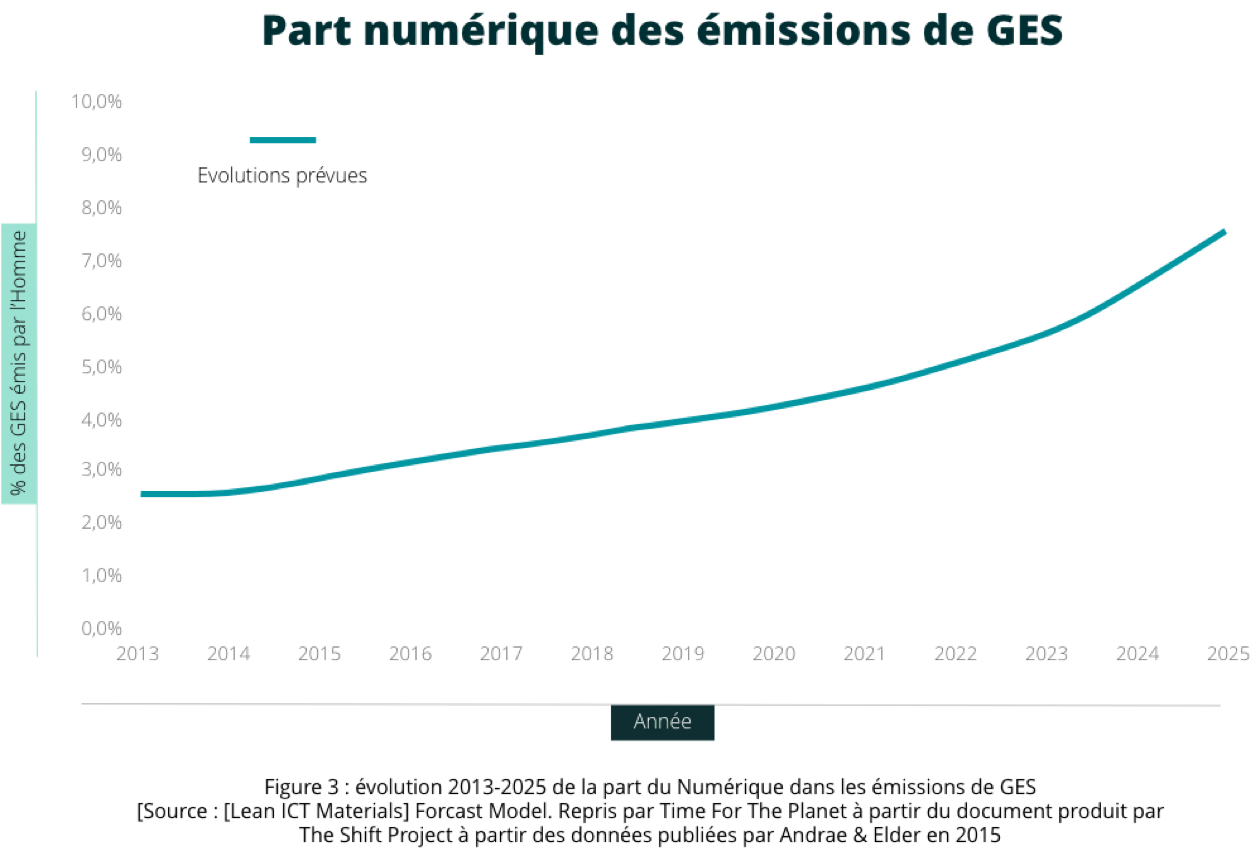
Apart from its GHG impact, the sector must also be closely monitored for other effects.
- It is using a growing over-sized share of available electricity which is increasing the strain on decarbonized power sources.
- It is also generating a growing demand for critical metals with limited availability, many of which are also essential for low-carbon technologies.
That’s why it is a bonus sector that has attracted our attention and falls into Team for the Planet’s scope. The sector has not yet been assessed or documented by the IPCC, but it is currently accounted for in the industry and energy sectors, one of our five priorities.
D. Team for the Planet’s 20 Issues
Having detailed our four actions and five priority sectors, we can now build a matrix which clearly sets out Team for the Planet’s scope for action.
We will identify, select and fund solutions that fall within this matrix. The 20 issues we intend to address are set out below.
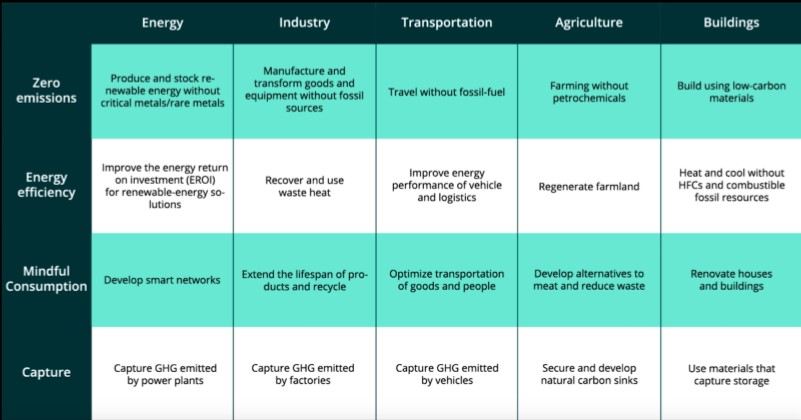
You will notice that we have particular priorities:
1. To decarbonize energy, we will rely on renewable energy and infinite flows.
2. To decarbonize our energy consumption on a large scale, we will rely on one of the key solutions which is energy storage.
3. To avoid fossil fuels (limited stock, security, etc.) in storage systems, we plan to develop energy storage solutions without critical or rare earth metals. We will also favor long-lasting innovations.
4. To develop renewable energy effectively, we will work to improve energy efficiency. Production is reaching a ceiling. This is not conducive to new users choosing renewable energy, creating significant availability problems.